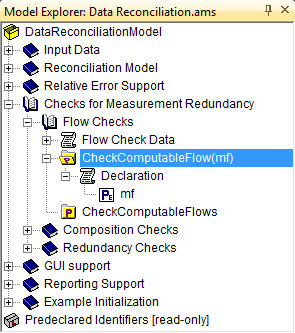Creating procedures and functions
Procedures and functions
Procedures and functions are the main means of executing the sequential tasks in your model that cannot be expressed by simple functional relationships in the form of identifier definitions. Such tasks include importing or exporting your model’s data from or to an external data source, the execution of data assignments, and giving AIMMS instructions to optimize a system of simultaneous equations.
Creating procedures and functions
Procedures and functions are added as a special type of node to the model tree, and must be placed in the main model, or in any book section. They cannot be part of declaration sections, which are exclusively used for model identifiers. Procedures and functions are represented by folder icons, which open up when the node is expanded. Fig. 24 illustrates an example of a procedure node in the model tree.
Naming and arguments
After you have inserted a procedure or function node into the tree, you have to enter its name. If you want to add a procedure or function with arguments, you can add the argument list here as well. Alternatively, you can specify the argument list in the attribute window of the procedure or function. The full details for adding arguments and their declaration as identifiers, local to the procedure or function, are discussed in Declaration of arguments and local identifiers. Whether or not the arguments are fully visible in the tree is configurable using the View menu.

Fig. 24 Example of a procedure node
Example of a procedure node
The attribute window of a procedure or function lets you specify or view
aspects such as its list of arguments, the index domain of its result,
or the actual body. The body may merely consists of a solve
statement to solve an optimization model, but can also consist of a
sequence of execution and flow control statements.
The contents of the Body attribute is application-specific, and is
irrelevant to a further understanding of the material in this section.
Specifying function domain and range
When the resulting value of a function is multidimensional, you can
specify the index domain and range of the result in the attribute form
of the function using the IndexDomain and Range attributes.
Inside the function body you can make assignments to the function name
as if it were a local (indexed) parameter, with the same dimension as
specified in the IndexDomain attribute. The most recently assigned
values are the values that are returned by the function.